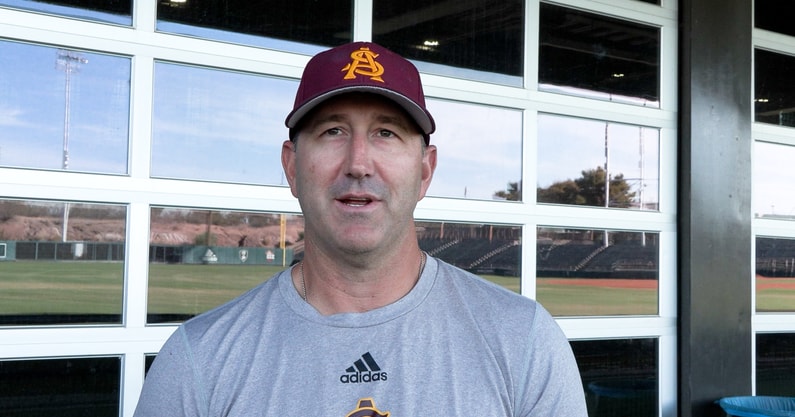Willie Bloomquist looks to build upon last season’s accomplishments


Arizona State baseball is stirring with purpose this fall, riding the momentum of a 36-win season that ended with the program’s first NCAA tournament appearance under head coach Willie Bloomquist and the first since 2021. The Sun Devils are no strangers to high expectations. A program with five national championships and 22 College World Series appearances rarely settles for participation, but last season offered a clear glimpse of what this team could become, a defining step in Bloomquist’s vision.
Now, with lessons learned and experience gained, ASU is channeling that energy into a deeper, more sustained push.
“Last year was a glimpse of what we can do,” Bloomquist stated. “It showed our guys what it takes to compete at the highest level. Now the challenge is to build on it.”
That building starts with culture. Over the past offseason, ASU made a major statement about why it proudly calls itself “MLBU.” Nine players departed for the MLB draft, led by Brandon Compton and Ben Jacobs, while graduates like Jacob Tobias and Josiah Cromwick also moved on.
While a testament to the program’s success, it left noticeable gaps that Bloomquist needed to fill. His challenge was not just assembling a team capable on the field but one that fully bought into the identity he’s cultivating.
“We have a lot of new faces,” Bloomquist noted, “but these are the right type of kids, guys who want to come here for the right reasons and are committed to putting in the work. They get it. They understand what it means to be a Sun Devil.”
Even so, ASU isn’t short on promising returners. Sophomore outfielder fielder Landon Hairston, who hit .333 and was named to All-Big 12 First Team last year, and junior right-handed pitchers Josh Butler and Wyatt Halvorson, each a top-six ERA finisher in the Cape Cod Baseball League and ready for increased roles, have risen to the challenge, demonstrating stability and accepting new leadership roles. Hairston has especially solidified himself as a foundation of the lineup.
“Landon leads by example,” Bloomquist explained. “You see the younger guys watching him, learning how to prepare, handle failure and get better every day.”
While returning talent forms the backbone of the team, much of ASU’s roster and nearly its entire starting lineup has been reshaped by the program’s 11th-ranked transfer portal class, a critical pipeline for adding depth, experience, and high-end talent after years of relying on walk-ons like Kien Vu and underrated add-ons. This influx of bigger-name transfers signals a serious investment in the team’s future.
Veteran right-hander Kole Klecker, who started out at TCU and hails from Chandler, returned home with three years’ worth of college experience. Utah redshirt sophomore infielder Austin Roellig, a .341 hitter and Big 12 Freshman All-American, and Cal junior infielder PJ Moutzouridis, a shortstop-in-waiting, all made a quick splash. Bloomquist insisted that contributions could not be delayed for this group.
“We needed guys who can contribute right now, who understand the grind and who bring leadership,” Bloomquist emphasized. “It’s not just about talent; it’s about fit.”
Depth and versatility from the transfer portal have been invaluable. Junior right-hander Alex Overbay, a UNLV transfer who served as the Rebels’ closer last season, has dominated fall workouts. Sophomore catcher Coen Nikolai, an Oregon transfer who was Alaska’s top catcher out of high school, fills the void left by Cromwick, providing stability behind the plate.
“Having that kind of depth is huge,” Bloomquist observed. “It lets us push guys, create competition and figure out the best lineup come spring.”
That depth has also amplified the progress of ASU’s pitching staff, the clearest reflection of the program’s evolution under pitching coach Jeremy Accardo. In just his second season, Accardo has transformed the group’s identity, cutting the team ERA from a Pac-12-worst 6.53 in 2024 to 5.38 this fall. His cutting-edge pitching lab — a mix of motion tracking, spin rate analysis, and traditional fundamentals — has become a cornerstone of the team’s development philosophy.
“They’re embracing the data, but they’re not letting it control them,” Bloomquist explained. “They’re still competing.”
That balance between analytics and competitiveness will be tested early. This spring, the Sun Devils face a deliberately demanding nonconference schedule designed to forge resilience and sharpen focus. Four SEC matchups, a five-game stretch featuring two against Oklahoma and a trip to Globe Life Field to face Mississippi State, Texas A&M and Tennessee form what Bloomquist calls “a trial by fire.”
After barely making the tournament last year as a last-in team, hampered by a late-season slump and few wins against top-tier opponents, this schedule is designed to test the Sun Devils and prevent a repeat.
“We want to challenge ourselves,” Bloomquist said. “If we can thrive against tough opponents in the fall, it gives us confidence when the season really counts.”
That confidence starts with experience. Veterans who played in the NCAA tournament now understand what it takes to win at that level and the demands it brings. Last season was a crucial learning experience, giving the team a glimpse of more and sparking a hunger to reach it. This offseason, Bloomquist intensified strength and conditioning work to build endurance, not just for the regular season but to carry the team deep into regionals and beyond.
“It’s about being ready for everything — the travel, the grind, the big moments,” Bloomquist reflected. “Last year showed them what it’s like. They’re not afraid now; they know the stakes.”
Still, the focus isn’t only on physical preparation. Fall ball has been about learning to respond under pressure, to compete when the game slips out of rhythm and to lean on each other in those moments. Bloomquist has emphasized development over results, holding players accountable while empowering them to take ownership of the program’s culture.
That message has defined ASU’s fall practices. It’s not just about matchups or scrimmages, but about building habits — development, accountability, and total buy-in. Bloomquist wants his players to take ownership of their roles and the direction of the team. The roster is still discovering its identity, testing boundaries, and embracing a demanding fall slate that mirrors postseason intensity.
“I love the attitude of this team,” Bloomquist shared. “They care about each other, the program and getting better every single day. That’s what we’re building on.”
This culture of accountability is underpinned by trust and stability. Bloomquist, entering the final year of his contract, offered a surprising hint at a potential extension when asked about his future.
“Talk to Graham,” Bloomquist remarked with a grin. “Because there’s something that should be happening soon.”
It was a subtle but telling nod, a quiet signal of confidence from the administration after a breakout season. While Bloomquist enters what might be considered a “prove it” year, much like ASU basketball coach Bobby Hurley, last season’s results tell a very different story. Hurley’s season ended with questions, while Bloomquist leaves no doubt, earning the trust of athletic director Graham Rosini and reinforcing a program once in transition.
Stability now surrounds ASU baseball, with leadership continuity reflecting the team’s growing maturity on the field.
With a roster blending experience, talent and buy-in, ASU is aiming higher than last year. Lessons from the tournament, the grind of fall practices and Bloomquist’s evolving culture have forged a group ready for adversity and opportunity. Players understand the stakes, one another, and the standard of wearing maroon and gold.
As the Sun Devils approach 2026, the focus goes beyond wins, aiming to build a lasting program where players leave the field better than they arrived and the coaching staff shapes their growth, continuing a tradition of excellence with hopes of adding more hardware to the trophy case. The hint of a contract extension, combined with Bloomquist’s trust in his roster, signals stability that matches the team’s ambition.
“This is just the beginning,” Bloomquist declared. “We’re not satisfied with glimpses. We’re building something that lasts — something the players, the staff and the fans can be proud of. And with this group, I know we’re capable of more than anyone expects.”
For Bloomquist, the vision extends beyond the scoreboard.
“We want to be a team that leaves everything on the field, that competes every day, and that grows together,” Bloomquist concluded. “That’s how you build something special, and that’s exactly what we’re doing here.”


